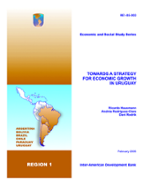Towards a Strategy for Economic Growth in Uruguay
Date
Feb 2005
The Uruguayan economy is recovering from the 2002 financial crisis that disrupted its banking system, caused a collapse of its currency and seriously affected its fiscal solvency. The crisis was clearly associated with the collapse of the Argentine economy and its concomitant currency, banking and debt crises. Both were also related to the sudden stop that followed the Russian crisis of 1998, which prompted an important realignment of the real in January 1999, a fact that had exerted enormous pressure on bilateral exchange rates within Mercosur. In this post-crisis period, Uruguay now faces several challenges to attain a sustainable growth path. This report proposes a series of recommendations towards this end. Implementing a strategy to accelerate growth inevitably involves interventions at both the macro and the micro level. The macro level involves the maintenance of a stable and competitive real exchange rate, so as to create a stable and encouraging environment for export growth. The authors take up each of these elements of the growth strategy. They first focus on the design of incentive policies for economic diversification and promotion. Then they discuss next the macroeconomic complements, with special emphasis on maintaining a competitive and stable real exchange rate.




